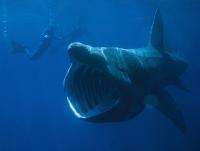Disappearing act of world's second largest fish explained

Researchers have discovered where basking sharks - the world's second largest fish - hide out for half of every year, according to a report published today in Current Biology. The discovery revises scientists' understanding of the iconic species and highlights just how little we still know about even the largest of marine animals, the researchers said.
"While commonly sighted in surface waters during summer and autumn months, the disappearance of basking sharks during winter has been a great source of debate ever since an article in 1954 suggested that they hibernate on the ocean floor during this time," said Gregory Skomal of Massachusetts Marine Fisheries. "Some 50 years later, we have helped to solve the mystery while completely re-defining the known distribution of this species."
Using new satellite-based tagging technology and a novel geolocation technique, the researchers found that basking sharks make ocean-scale migrations through tropical waters of the Atlantic Ocean during the winter, traveling at depths of 200 to 1,000 meters. Their data show that the sharks sometimes stay at those depths for weeks or even months at a time. "In doing so, they have completely avoided detection by humans for millennia," Skomal said, emphasizing that as one of the very largest of marine animals, the sharks grow to over 10 meters and weigh as much as seven metric tons.
Skomal said they were "absolutely surprised" when they first received a signal from the tagged sharks coming from the tropical waters of the western Atlantic, in the vicinity of the Caribbean and Bahamas. After all, basking sharks were always believed to be cool-water sharks, restricted to temperate regions.
Several factors had made basking sharks a challenge to study. On top of the fact that they disappear for long periods of time, they also feed exclusively on plankton. That means they can't readily be captured with traditional rod-and-reel methods. And even when the sharks are found closer to the ocean surface, they spend their time in the cool-temperature, plankton-rich waters that limit underwater visibility and make diving difficult.
The findings could have important implications for the conservation of basking sharks, which have shown some signs of dramatic decline in the last half century and are listed as threatened by the International Union for Conservation of Nature.
"Coupled with recent genetic data, our finding indicates that the Atlantic population - and perhaps the world population - are connected and may constitute a single population," Skomal said. "Hence, the global population of basking sharks may be even smaller than previously thought." Efforts to boost basking sharks' numbers will therefore need to be coordinated at a global scale.
Source: Cell Press (news : web)















